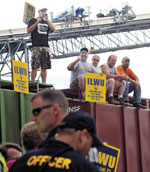
Showdown on West Coast Docks: The Battle of Longview
(November 2011).
click on photo for article
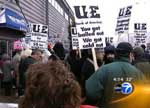
Chicago Plant Occupation Electrifies Labor
(December 2008).
click on photo for article
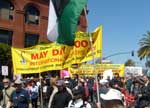
May Day Strike Against the War Shuts
Down
U.S. West Coast Ports
(May 2008)
click on photo for article

June 2016
Unionize
Verizon Wireless, Aid Philippines Call Center
Workers!
Verizon Strike Beats Back
Company Assault,
But With Big Healthcare Givebacks
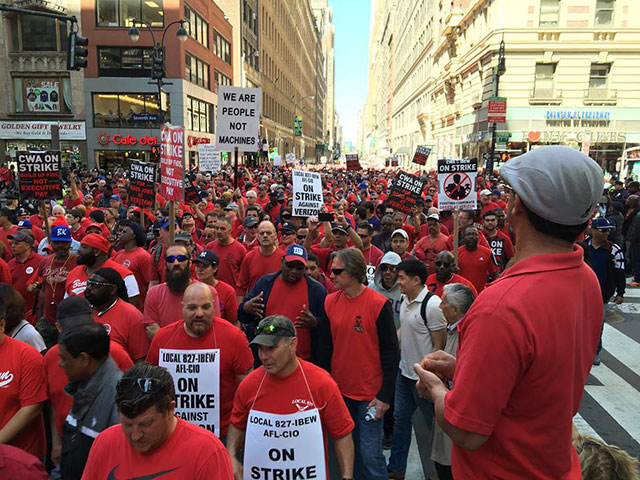
Huge rally of 14,000 striking CWA and IBEW Verizon workers floods the streets of Manhattan, April 18. (Internationalist photo)
JUNE 12 – From April 13 to May 27, close to 40,000 members of the Communication Workers of America (CWA) and the International Brotherhood of Electrical Workers (IBEW) waged a determined strike against Verizon Communications Inc. This was the largest and most important strike by workers in the U.S. in recent years. The multiracial Verizon workforce showed courage and perseverance, and an enthusiasm for the strike that was palpable at pickets and mass rallies. Workers expressed a lot of pride for waging the fight and for the solidarity they maintained and built through 45 days on the picket line, which was no easy feat. In New York, we also saw how the strike inspired other workers, as trucks and innumerable delivery vans and cars blew their horns while drivers showed clenched fists.
As the strike ground on, the company was about to be faced with paying unemployment charges. At the same time, Obama had sent in a federal mediator, and Labor Secretary Perez was applying pressure. While some had illusions that this was aiding the workers, the National Labor Relations Board hit the strikers with injunctions limiting pickets, and then tried to stop the boisterous picketing of hotels housing scabs. The strikers were sent back to work without seeing any contract, while scabs were still working. After 45 days on the line, many felt some relief, while others were rightly suspicious – especially in light of past sellouts and being sent back suddenly with worse than nothing in 2011.
The strike came on the heels of the company stonewalling contract negotiations for eight months (while raking in a cool $1.3 billion in monthly profits). Among the company’s chief demands for givebacks were big increases to health care costs, forcible months-long relocations to service distant parts of the company’s wireline network, and significantly slashing the number of call-center union jobs (in order to savagely exploit workers in the Philippines, India and Mexico). The 7% raise the company was offering would have been a pay cut once health care costs and inflation were taken into account.
CWA and IBEW union tops are crowing that the outcome of the strike was a victory. Workers are now voting on a “tentative agreement” on the basis of a ten-page summary. They are slated to get a 10.9% wage increase (compounded) over four years, and a number of the most egregious company demands were beaten back, including the forcible relocations. Company plans to shut down call centers were scaled back, while 1,300 new unionized call-center jobs would be created. But Verizon and business analysts are underscoring a big win for the company, that the “unions agreed to shoulder hundreds of millions of dollars more in health-care costs” and “union members will be paying higher monthly premiums and out-of-pocket [medical] expenses” (Wall Street Journal, 31 May). In fact, CWA/IBEW negotiators had already agreed to huge health-care givebacks even before the strike. While the summary says “overall” wage increases will “more than pay for the new costs under the health plan,” when inflation is factored in workers may be treading water at best.
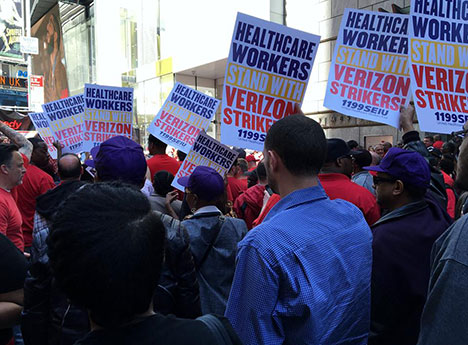 Verizon strike inspired other workers, as in
this 1199 contingent in April 18 strike rally. But to win
big would have required bringing out other sectors in
joint strike action.
Verizon strike inspired other workers, as in
this 1199 contingent in April 18 strike rally. But to win
big would have required bringing out other sectors in
joint strike action. (Internationalist photo)
A real union victory, in which substantial gains were made, would have required a very different strategy and a union leadership committed to class struggle. An April 25 Internationalist leaflet called to “stop the scabs, build mass picket lines no one dares cross” and to unite with the call-center workers in Philippines and elsewhere being paid starvation wages by this profit-gorged company. Moreover, the 15,000 AT&T West workers represented by CWA were kept on the job even though their contracts had expired. Instead, they should have been brought out on strike for a joint struggle of phone workers across the country.
The strike offered a glimpse at the possibility of mobilizing working-class power. Workers picketing outside Verizon Wireless stores chanted “What’s disgusting!? Union-busting!” and eagerly adopted our slogan of “Picket lines mean don’t cross!” As a result of the pickets, Wireless stores saw a sharp drop in foot traffic. The few customers who entered faced a barrage of whoops and hollers, lambasting them for crossing a picket line of people who were on strike to maintain a decent life for themselves and their families. Numerous passers-by expressed support for the striking workers, with some businesses even donating free food and water – daily. As for the scabs, they were greeted by picket line “wake-up” calls every morning outside the hotels housing them … until the NLRB injunction banned strikers from doing this in mid-May, for being a “secondary boycott.” But the union leadership generally did not try to stop scabs at the garages and central offices.
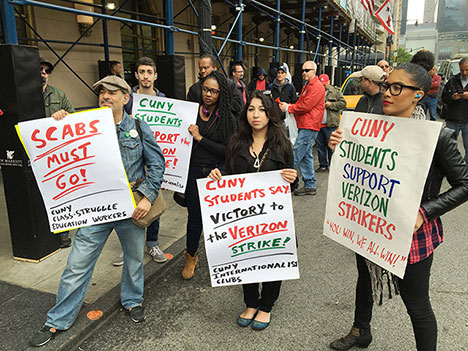 CUNY Internationalist Club
students and Class Struggle Education Workers at April 26
Verizon strike rally outside hotel housing scabs.
CUNY Internationalist Club
students and Class Struggle Education Workers at April 26
Verizon strike rally outside hotel housing scabs. (Internationalist photo)
The Internationalist Clubs at the City University of New York, Class Struggle Education Workers (CSEW), and the Internationalist Group (IG) were a presence on these picket lines in the New York City area starting on Day One. It was an important learning experience for young revolutionaries from CUNY, and their sustained presence on the picket line was much commented on by many strikers. One Internationalist Club member was told by a cop that she would have to move from in front of a Verizon Wireless store. She refused. The officer cited the injunction. She replied that it did not apply to her. When he insisted, she demanded “show me.” After going into the store to consult, he came back out after a few minutes conceding her point. The strikers appreciated how she stood her ground. “That was a big push for us all,” said the picket captain.
Verizon Beaten Back, But Far From Beaten
The sharpest edges of the company’s union-busting assault have been blunted, for now, but the settlement is nowhere near what could or should have been won, and includes plenty of bad news. It reportedly stipulates that retirees are to be switched over from premium insurance plans to Medicare Advantage plans in order to save the company “significant money,” which these former Verizon workers will have to cover. Active service workers, particularly those with dependents, may be hit with thousands of extra dollars per year in payments for medical care, between increased premiums, co-pays, deductibles and “out-of-pocket maximum” charges.
As for the new call-center jobs, those would be in the second tier (with no defined-benefit pensions, which the unions gave up in the 2011 sellout contract). Moreover, Verizon has gained the right to reduce the volume of calls to certain call centers, which would then be used to “justify” their closure on the basis of low call volume. In addition, the company can now offer buyout incentives for workers without union permission – another way of slowly but surely eliminating the number of union workers with defined-benefit pensions.
The Quality Assurance Review (QAR) program, used by management to target and dole out suspensions on the basis of “productivity,” has been one of the most hated weapons in Verizon’s anti-worker arsenal. Union tops would have workers believe that the QAR is gone, but it is replaced with … a joint operation between management and the union. This gives the company carte blanche to engage in the same blatant targeting of workers as under the former QAR, except that since the unions are now involved, management can shift the blame. (Plus it would be much harder than it already is to file grievances against these disciplinary measures.)
Verizon backed off on some of its demands, in part because the picketing of Verizon Wireless was more effective than it expected, and because its management (and other) scabs couldn’t tackle installation, repair and maintenance. But analysts agreed that another important factor was the company’s intent to get rid of the unionized wireline business altogether and focus on its non-unionized wireless operations. A New York Times (30 May) article quoted one of these analysts:
“‘They needed to end the strike and they bit the bullet,’ said Roger Entner of Recon Analytics. He said he thinks the deal ‘reinforced their commitment to basically exiting’ wireline, which he called ‘the least profitable, most problematic part of the business.’ The new contract ‘gives Verizon four years basically to get rid of the unit. Let it be somebody else’s problem.’ Entner said.”
The next day, in a piece for Fierce Telecom, a leading telecommunications industry publication, Entner went on:
“With the strike now over, Verizon management must wonder if the remaining wireline activities are worth the distraction it creates on a regular basis. Their answer will almost inevitably be ‘no,’ especially because Verizon seems to have a significantly more acrimonious relationship with its unions than AT&T. A sale of the remaining wireline assets beyond what it needs to operate its wireless backbone is the way to go.”
Verizon workers faced repeated acts of strike-braking violence – a company lawyer hit a striker with his Porsche, a drunk scab struck a striker with his truck, a scab pulled out a machete on a striker, and a cop ran a scab-filled van into a striker’s car while he was in it. The memory of Gerry Hogan, who was killed when a scab hit him with her van during the 1989 strike, was rightly invoked by union members. Scab and police violence is no coincidence. The cops are not neutral, they are the armed enforcers of capitalist “law and order.” “Just doing their job” means protecting the bosses’ property, and the whole system of exploitation and oppression. During a strike this means making sure scabs can scab and workers do not get “out of line” – like shutting down production.
Another example of how the cops are capital’s enforcers was the CWA’s encounter with a SWAT team in the Philippines. In an act of international workers solidarity, the BPO Industry Employees Network (BIEN) invited the CWA to the Philippines to witness the horrid working conditions Verizon subjects its Filipino call-center workers to – getting paid a meager $1.78 per hour, forced overtime and a mandatory six-day week. Together with employees from Teletech Nova (a call-center contractor hired by Verizon), BIEN activists, members of the May First Labor Movement (Kilusang Mayo Uno, or KMU), and members of the UNI Global Union, representatives from the CWA were confronted by masked police brandishing automatic weapons. The unionists’ crime? Trying to get a statement from Verizon about its Filipino operations.
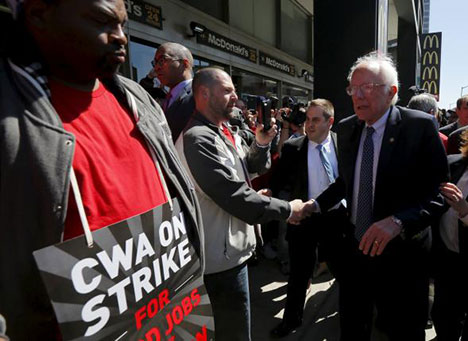 Bernie Sanders gladhanding in Brooklyn on
the first day of the strike. The Democratic Party
“socialist” is actually a capitalist politician. Breaking
labor from the Democrats is key to reversing decades
of labor defeats. Build a class-struggle workers party!
Bernie Sanders gladhanding in Brooklyn on
the first day of the strike. The Democratic Party
“socialist” is actually a capitalist politician. Breaking
labor from the Democrats is key to reversing decades
of labor defeats. Build a class-struggle workers party!(Internationalist photo)
During the strike, CWA bureaucrats staged events to showcase Democratic presidential contenders Hillary Clinton and especially Bernie Sanders, whom they endorsed. But Sanders, like Clinton, is a bourgeois politician, a supporter of capitalism. Various left groups are also pushing this Democratic Party “socialist,” including the International Socialist Organization, which had this to say about Sanders’ “left-wing campaign”: “Having encouraged members to be active in the Sanders campaign and support his anti-corporate themes, the CWA leadership prepared the ground politically for taking on the bosses” (Socialist Worker, 3 June). Really? Like hell. As we noted in our April 25 leaflet, Sanders “cites the police (!) as an example of what he considers a ‘socialist institution’.” Chaining workers to the Democratic Party as the union bureaucracy does is a roadblock to taking on the bosses with real class struggle. In fact, subjugation to the bosses’ parties and politicians is the No. 1 problem facing U.S. labor, and the key to its many defeats over the past decades.
The World Socialist Web Site (WSWS) published articles on the strike and distributed leaflets at Verizon pickets. But what they were pushing was anti-union propaganda. In a piece titled “Lessons of the Verizon strike” (June 2), these fake-left union-bashers claim that unions “are not working class organizations, but arms of corporate management and the state.” They deliberately equate the sellout labor bureaucracy with the unions themselves. Class-struggle unionists fight to drive out the pro-capitalist bureaucracy so that the unions actually act as powerful defensive organizations of the working class against capital.
What the workers of the CWA need now more than ever is a class-struggle leadership that will not be afraid to use the power of the working class. It means building mass pickets that actually shut down operations. It means forming elected mass strike committees that are recallable at any time, to stop back-room deals and put control of the struggle in the hands of the membership. It means waging an all-out fight to unionize Verizon Wireless, and providing real and substantial aid to Verizon call-center workers to unionize from the U.S. to Philippines, Mexico and India, instead of flag-waving appeals about “saving American jobs” from the union tops and Democratic Party politicians like Sanders. Above all, it means building a workers party in sharp struggle against all the capitalist parties and politicians, to lead the fight for a workers government, here and around the world. ■